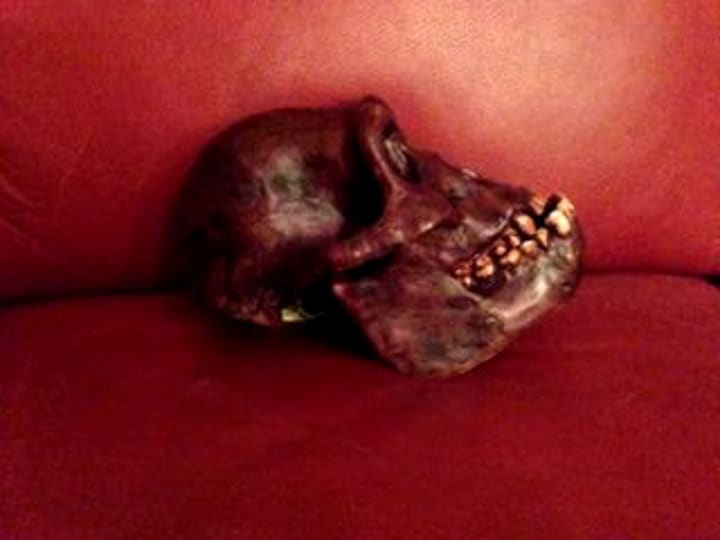
PAREIDOLIA : is a psychological phenomenon involving a stimulus wherein the mind perceives a familiar pattern of something where none actually exists. Common examples are perceived images of animals, faces, or objects in cloud formations, the man in the moon, the moon rabbit, and hidden messages within recorded music played in reverse or at higher- or lower-than-normal speeds. Example : seeing a human face in the marble pattern of the tile floor.
Why People See Faces When There Are None: Pareidolia
On the phenomenon of seeing things that are not there
Posted Aug 09, 2016
Written by Frederick L. Coolidge and Melissa L. Coolidge
One night my wife and I had a red wine accident on our living room couch. The couch was covered with an Indian shawl. The next day, I held up the shawl and saw the following:

photo iPhone 2015 742.jpg
As I am a cognitive archaeologist, that is, one who applies cognitive and psychological models to archaeological artifacts and to anthropology, I was stunned to see an image of Lucy, Australopithecus afarensis. Lucy, of course, is our most known distant ancestor, dating back to about 3.2 million years ago. I knew that this tendency for all humans to perceive a face or pattern where one actually doesn’t exist is called pareidolia. Part of the psychological phenomenon of pareidolia is similar to the Rorschach Inkblot Test, where one unconsciously projects one’s feelings, attitudes, and prior experiences onto an inherently meaningless inkblot. Interestingly, the Rorschach has been called ‘directed pareidolia.’ One also might project one’s interests, wishes, and desires, and thus, it was not surprising that I would immediately see the skull of Lucy. I took my replica of Lucy’s skull and snapped the following photo:

photo iPhone 2015 743.jpg
The neurological foundation for pareidolia resides primarily in an area of the temporal lobes of the brain called the fusiform gyrus, where humans and other animals (primarily modern great apes) have neurons dedicated to the recognition of faces and other objects. Ontogenetically, it would be important for infants to recognize and distinguish faces for sustenance and sociality. Astronomer Carl Sagan in his 1996 book, The Demon-Haunted World, noted that infants who could not recognize their parents’ faces were less likely to win their parents’ hearts, and thus less likely to prosper. Evolutionarily, it would be critically important to recognize faces (and other objects, both animate and inanimate) immediately for those two reasons and additionally to recognize predators and other threats in the environment. Sagan informally labeled the “inadvertent side effect” of this phenomenon “the pattern-recognition machinery” (p. 45), where “we sometimes see faces where there are none” (p. 45). Sagan also gave examples of seeing faces in rocks, vegetables, wood, and of course the face of Jesus, which has been seen in tortillas, windows, and other objects. Rocks and cave formations that resemble faces or other objects are called mimetoliths and one of the most famous mimetoliths in archaeology may be the berekhat ram figurine, dating to about 233,000 years ago.

photo BR Picture1.jpg
Although, this little rock (about 1.4 inches tall) was enhanced by its carver, it was undoubtedly chosen because it already mimicked a human form. Well known skeptic/writer Michael Shermer has claimed further that brains are ‘belief engines’ with a strong predilection to detect a pattern where no pattern might exist and attribute some sense of agency or causation to the patterns rather than the mundane alternative of simple chance or randomness. As Yale Psychologist Robert P. Abelson once said, “Attributing a data set to mere chance is often deflating” (1995, p. 24). Additionally, Shermer claimed that people would then seek out confirmatory evidence for their perceptions and even deny or ignore contradictory claims.
It is also important to note the evolutionary consequences of seeing a pattern where there is none (a false positive) as opposed to failing to see a pattern where there is one (a false negative). It seems clear that the consequences of a false positive, especially when it involves the recognition of a predator, are not as severe as the consequences of a false negative. In other words, seeing a lion where this is no lion is rarely lethal. However, failing to see a predatory lion, of course, would often be deadly. Thus, pareidolia can be a fascinating and entertaining phenomenon at all sorts of levels: psychologically, developmentally, neurologically, and evolutionarily.
https://www.psychologytoday.com/blog/how-think-neandertal/201608/why-people-see-faces-when-there-are-none-pareidolia
About the Creator
Rebecca K
As a lover of arts and the the truth I enjoy writing. It allows me to express myself while sharing life lessons, precious moments and even the unspeakable moments. I encourage feedback on my posts so feel free to speak your mind. Thank you






Comments
There are no comments for this story
Be the first to respond and start the conversation.